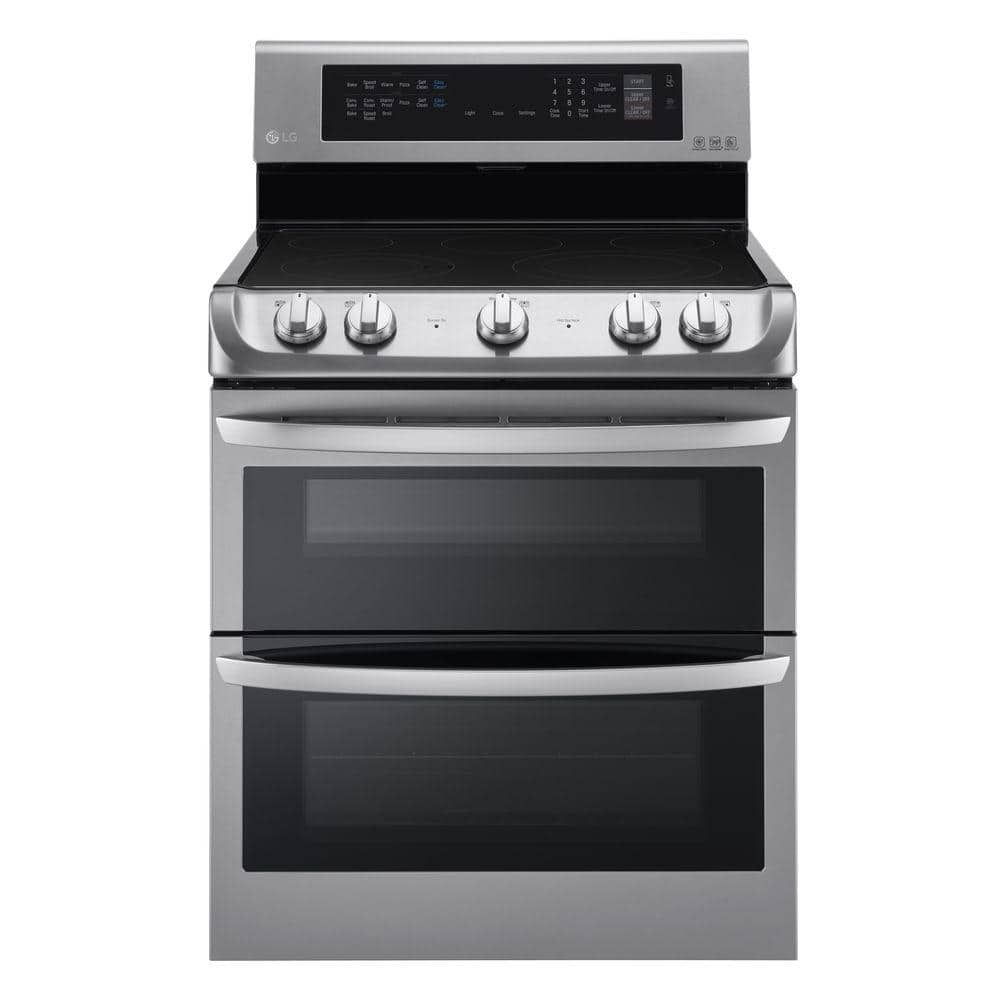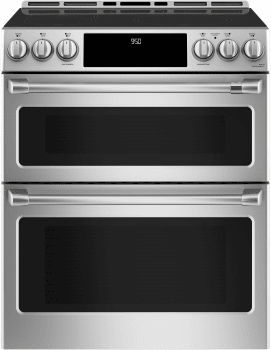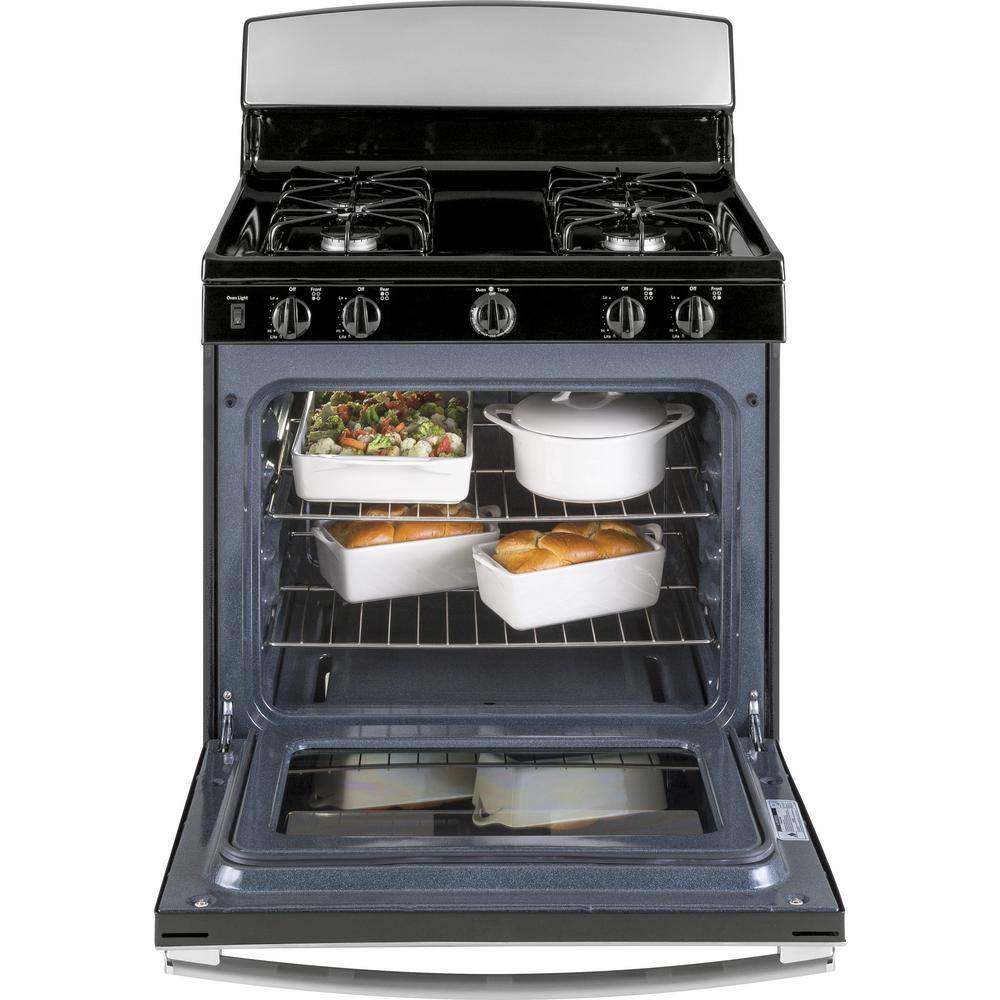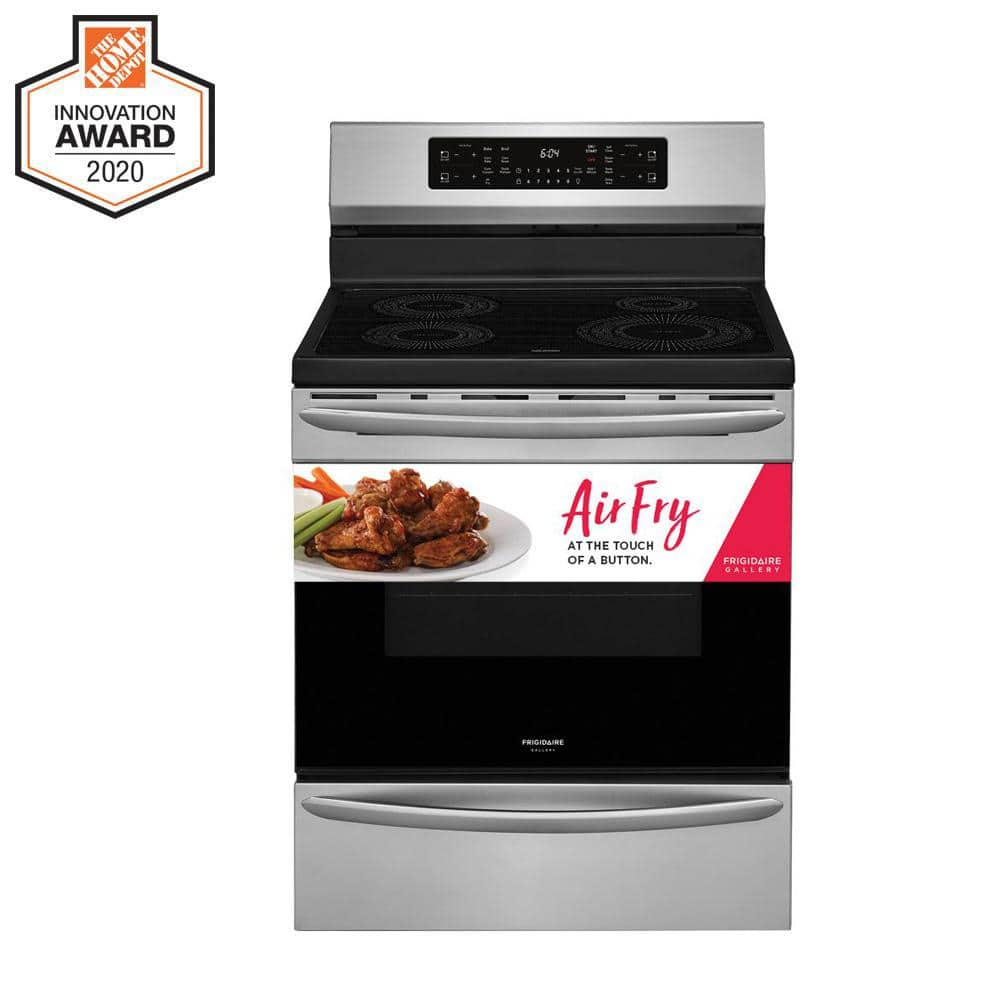LG 7.3 cu. ft. Double Oven Electric Range with ProBake Convection, Self Clean and EasyClean in Stainless Steel
-
( 7 Reviews )Rated 4.86 out of 5 based on 7 customer ratings07
Cook multiple dishes at once with 7.3 cu. ft. double oven. ProBake convection oven delivers even baking results. 5 radiant stove top elements provide cooking/warming flexibility.
-
Cafe 30″ Slide-In Electric Range CHS950P2MS1
Rated 4.33 out of 503Cafe 30″ Slide-In Electric Range CHS950P2MS1
Rated 4.33 out of 503 -
GE 4.8 cu. ft. Gas Range in Stainless Steel
Rated 4.67 out of 503GE 4.8 cu. ft. Gas Range in Stainless Steel
Rated 4.67 out of 503
This LG 7.3 cu. ft. Electric Double Oven Range with ProBake Convection features two large-capacity ovens that lets you prepare everything from a holiday roast and all the sides to pans and pans of cookies all at once. This unit allows you to bake faster and more evenly than traditional convection ovens. Of course, with big meals come big messes, so LG’s EasyClean Express makes cleanup as simple as 10 minutes and three easy steps. Plus, the sleek, easy access controls make it easy to cook (and look) like a pro.
- LG ProBake Convection delivers even baking results on every rack, every time: the heating element was moved from the bottom of the oven to the back wall for optimal heat distribution
- Sleek, angled controls put power and visibility at your fingertips while bringing an updated, stylish look to your kitchen
- EasyClean delivers a superior clean in a 10 quick minutes and three easy steps to leave your oven sparkling fresh without strong chemical fumes or high heat – simply spray the oven interior with water, press EasyClean and then in 10 minutes quickly wipe away any leftover grime
- Simplify dinnertime with LG’s 7.3 cu. ft. double oven, offering the largest capacity available
- Use the quick-heating upper oven for smaller meals on the go; for big events, you’ll have the room you need to cook all your favorite dishes, at different temperatures, at the same time
- With 3200-Watt, these dual cooktop elements are the most powerful available – not only do they deliver LG’s fastest boil, they let you match the element size to your cookware for the utmost in flexibility
- LG offers versatile elements that fit different sized cookware for convenience – even your largest saute pan
- Intuitive SmoothTouch glass controls easily wipes clean and not only look sleek, but makes operating your range a snap with just a touch of your finger
- Brilliant blue interior provides an upscale look with premium interior design
- Supersized window allows you to easily check the progress of a meal, no matter where it’s placed in the oven
- Enjoy the capacity, flexibility and performance for your biggest meals in LG Double Ovens
- Lower oven features ProBake Convection that delivers even baking results on every rack, every time
- Offers versatile cooking settings with and without convection
- LOCK Function: when cooktop is turned on by the action of turning the knobs, it activates a switch that sends an electrical signal to power the cooktops; when the LOCK function is enabled, this signal is blocked, preventing the cooktops and oven from activating
- Download the SmartThinQ application to enable the smart cooking feature; store your favorite recipes, search Food Channel recipes and sync with your oven, and it will adjust the operating settings to follow the instructions
- Large capacity allows for varying size dishes
Additional information
| Depth With Door(s) Open 90 Degrees (In.) | 40.93 |
|---|---|
| Lower Oven Interior Depth x Height x Width (in) | 19.937 x 14.25 x 24.81 |
| Upper Oven Interior Depth x Height x Width (in) | 19.81 x 10.8 x 24.8 |
| Product Depth x Height x Width (in) | 28.9 x 47.3 x 29.94 |
| Range Size | 30 in. |
| Certifications and Listings | ETL Listed |
| Manufacturer Warranty | 1 year parts and labor |
3 (three) is a number, numeral and digit. It is the natural number following 2 and preceding 4, and is the smallest odd prime number and the only prime preceding a square number. It has religious and cultural significance in many societies.
7 (seven) is the natural number following 6 and preceding 8. It is the only prime number preceding a cube.
As an early prime number in the series of positive integers, the number seven has greatly symbolic associations in religion, mythology, superstition and philosophy. The seven classical planets resulted in seven being the number of days in a week. 7 is often considered lucky in Western culture and is often seen as highly symbolic.
Clean may refer to:
- Cleaning, the process of removing unwanted substances, such as dirt, infectious agents, and other impurities, from an object or environment
- Cleanliness, the state of being clean and free from dirt
Convection is single or multiphase fluid flow that occurs spontaneously through the combined effects of material property heterogeneity and body forces on a fluid, most commonly density and gravity (see buoyancy). When the cause of the convection is unspecified, convection due to the effects of thermal expansion and buoyancy can be assumed. Convection may also take place in soft solids or mixtures where particles can flow.
Convective flow may be transient (such as when a multiphase mixture of oil and water separates) or steady state (see convection cell). The convection may be due to gravitational, electromagnetic or fictitious body forces. Heat transfer by natural convection plays a role in the structure of Earth's atmosphere, its oceans, and its mantle. Discrete convective cells in the atmosphere can be identified by clouds, with stronger convection resulting in thunderstorms. Natural convection also plays a role in stellar physics. Convection is often categorised or described by the main effect causing the convective flow; for example, thermal convection.
Convection cannot take place in most solids because neither bulk current flows nor significant diffusion of matter can take place. Granular convection is a similar phenomenon in granular material instead of fluids. Advection is fluid motion created by velocity instead of thermal gradients. Convective heat transfer is the intentional use of convection as a method for heat transfer. Convection is a process in which heat is carried from place to place by the bulk movement of a fluid and gases.
LG Corporation (or LG Group), formerly known as Lucky-Goldstar, is a South Korean multinational conglomerate founded by Koo In-hwoi in 1947 and managed by successive generations of his family. It is the fourth-largest chaebol (family-run conglomerate) in South Korea. Its headquarters are in the LG Twin Towers building in Yeouido-dong, Yeongdeungpo District, Seoul. LG makes electronics, chemicals, household appliances, and telecommunications products and operates subsidiaries such as LG Electronics, Zenith, LG Display, LG Uplus, LG Innotek, LG Chem, and LG Energy Solution in over 80 countries.
An oven is a tool that is used to expose materials to a hot environment. Ovens contain a hollow chamber and provide a means of heating the chamber in a controlled way. In use since antiquity, they have been used to accomplish a wide variety of tasks requiring controlled heating. Because they are used for a variety of purposes, there are many different types of ovens. These types differ depending on their intended purpose and based upon how they generate heat.
Ovens are often used for cooking, usually baking, sometimes broiling; they can be used to heat food to a desired temperature. Ovens are also used in the manufacturing of ceramics and pottery; these ovens are sometimes referred to as kilns. Metallurgical furnaces are ovens used in the manufacturing of metals, while glass furnaces are ovens used to produce glass.
There are many methods by which different types of ovens produce heat. Some ovens heat materials using the combustion of a fuel, such as wood, coal, or natural gas, while many employ electricity. Microwave ovens heat materials by exposing them to microwave radiation, while electric ovens and electric furnaces heat materials using resistive heating. Some ovens use forced convection, the movement of gases inside the heating chamber, to enhance the heating process, or, in some cases, to change the properties of the material being heated, such as in the Bessemer method of steel production.
In philosophy, the self is an individual's own being, knowledge, and values, and the relationship between these attributes.
The first-person perspective distinguishes selfhood from personal identity. Whereas "identity" is (literally) sameness and may involve categorization and labeling, selfhood implies a first-person perspective and suggests potential uniqueness. Conversely, "person" is used as a third-person reference. Personal identity can be impaired in late-stage Alzheimer's disease and in other neurodegenerative diseases. Finally, the self is distinguishable from "others". Including the distinction between sameness and otherness, the self versus other is a research topic in contemporary philosophy and contemporary phenomenology (see also psychological phenomenology), psychology, psychiatry, neurology, and neuroscience.
Although subjective experience is central to selfhood, the privacy of this experience is only one of many problems in the philosophy of self and scientific study of consciousness.
Stainless may refer to:
- Cleanliness, or the quality of being clean
- Stainless steel, a corrosion-resistant metal alloy
- Stainless Games, a British video game developer
- Stainless Broadcasting Company, a TV broadcaster based in Michigan, US
- Stainless Banner, the second national flag of the Confederate States of America
Steel is an alloy of iron and carbon with improved strength and fracture resistance compared to other forms of iron. Because of its high tensile strength and low cost, steel is one of the most commonly manufactured materials in the world. Steel is used in buildings, as concrete reinforcing rods, in bridges, infrastructure, tools, ships, trains, cars, bicycles, machines, electrical appliances, furniture, and weapons.
Iron is always the main element in steel, but many other elements may be present or added. Stainless steels, which are resistant to corrosion and oxidation, typically are 11% chromium.
Iron is the base metal of steel. Depending on the temperature, it can take two crystalline forms (allotropic forms): body-centred cubic and face-centred cubic. The interaction of the allotropes of iron with the alloying elements, primarily carbon, gives steel and cast iron their range of unique properties. In pure iron, the crystal structure has relatively little resistance to the iron atoms slipping past one another, and so pure iron is quite ductile, or soft and easily formed. In steel, small amounts of carbon, other elements, and inclusions within the iron act as hardening agents that prevent the movement of dislocations.
The carbon in typical steel alloys may contribute up to 2.14% of its weight. Varying the amount of carbon and many other alloying elements, as well as controlling their chemical and physical makeup in the final steel (either as solute elements, or as precipitated phases), impedes the movement of the dislocations that make pure iron ductile, and thus controls and enhances its qualities. These qualities include the hardness, quenching behaviour, need for annealing, tempering behaviour, yield strength, and tensile strength of the resulting steel. The increase in steel's strength compared to pure iron is possible only by reducing iron's ductility.
Steel was produced in bloomery furnaces for thousands of years, but its large-scale, industrial use began only after more efficient production methods were devised in the 17th century, with the introduction of the blast furnace and production of crucible steel. This was followed by the Bessemer process in England in the mid-19th century, and then by the open-hearth furnace. With the invention of the Bessemer process, a new era of mass-produced steel began. Mild steel replaced wrought iron. The German states were the major steel producers in Europe in the 19th century. American steel production was centred in Pittsburgh, Bethlehem, Pennsylvania, and Cleveland until the late 20th century. Currently, world steel production is centered in China, which produced 54% of the world's steel in 2023.
Further refinements in the process, such as basic oxygen steelmaking (BOS), largely replaced earlier methods by further lowering the cost of production and increasing the quality of the final product. Today more than 1.6 billion tons of steel is produced annually. Modern steel is generally identified by various grades defined by assorted standards organizations. The modern steel industry is one of the largest manufacturing industries in the world, but also one of the most energy and greenhouse gas emission intense industries, contributing 8% of global emissions. However, steel is also very reusable: it is one of the world's most-recycled materials, with a recycling rate of over 60% globally.
With or WITH may refer to:
- With, a preposition in English
- Carl Johannes With (1877–1923), Danish doctor and arachnologist
- With (character), a character in D. N. Angel
- With (novel), a novel by Donald Harrington
- With (album), a 2014 album by TVXQ
- With (EP), a 2021 EP by Nam Woo-hyun






by Chris
We’ve only had our oven for a few weeks and I so wish we’d gotten it sooner. The design of this oven is so sleek and sexy. This is truly my dream oven. The double ovens make it so much easier to get things cooked and done at the same time. Don’t even get me started on the convection. It cooks so evenly..don’t know how I’ve gone this long without it.
by Oscar
Not sure I care for the larger oven being on the bottom. So far I love the stove but will have to get used to the ovens.
by Jason
This LG stove/dual oven is perfect for our needs. The dual ovens allow me to prepare multiple food items at different temperatures at the same time. This is ideal for large family gatherings and entertaining.
by Arianan
I’ve had this a couple months now and use the double oven feature several times a week. The largest burner is big and can only be used with large pans but all the other burners accommodate normal pans. Very satisfied.
by Arthur
Both the stovetop and oven perform excellently. The heavy knobs provide precise control of the burners and the oven cooks evenly and accurately. We’ve found the double oven a bit of a mixed blessing. Access to the lower oven (which has convection and a proofing function) is difficult. It’s very low and the racks don’t easily slide. The stovetop has a bit of a texture and can’t be easily scraped.
by Stuart
This range is easy to use and is dependable. The controls are simple. The convection oven is great for oven-crisping like an air fryer. The only drawbacks are the oven racks, which don’t slide easily, and the cooktop burners’ slow heating.
by Scott
I bought this oven about a month ago. I thought the oven I had was ok, but after using this one for a couple of weeks I released what I was missing. The food is cooked evenly and food like meat loaf and chicken pot pies came out with a much better consistency. It is hard to explain but the food is much better than with my old stove.